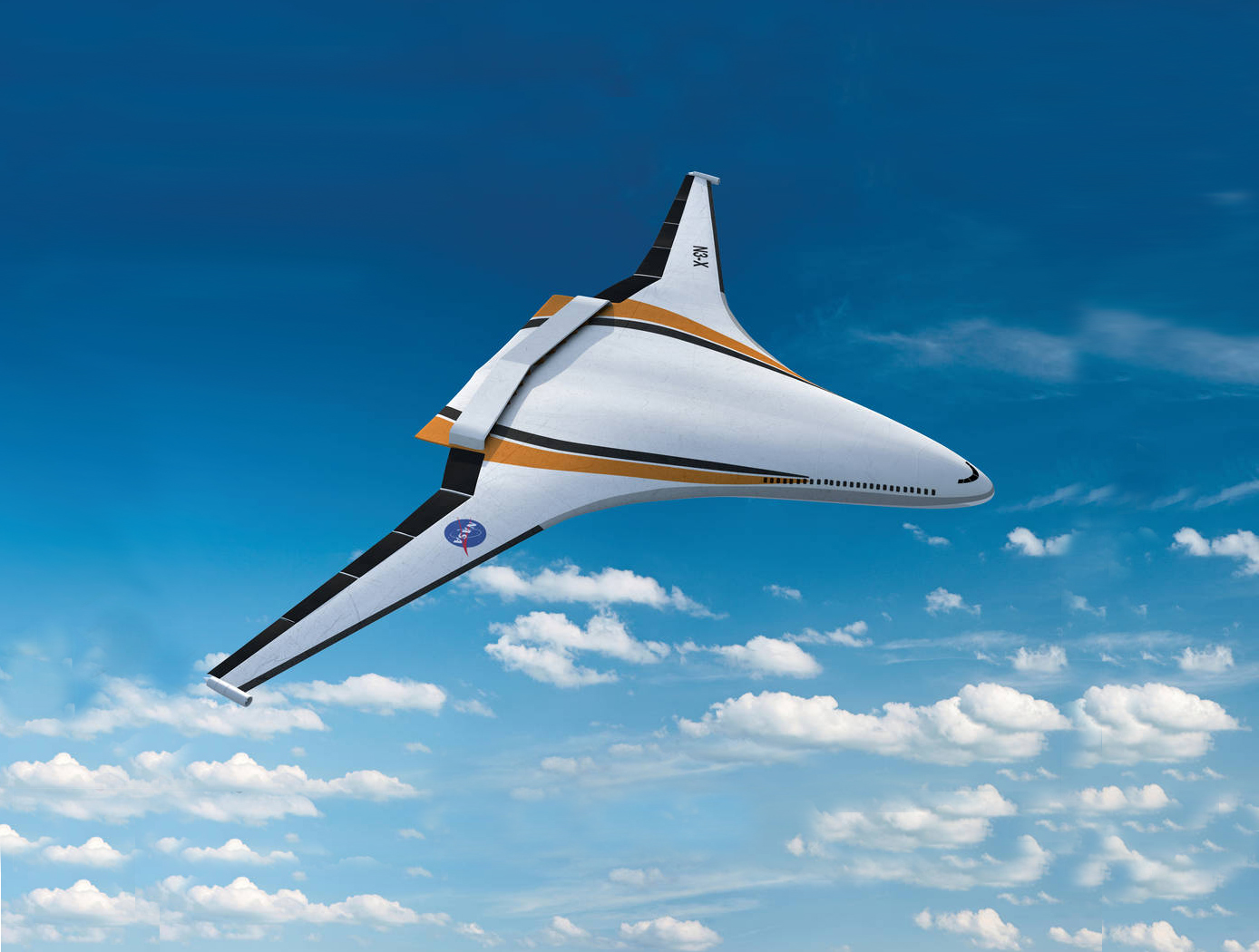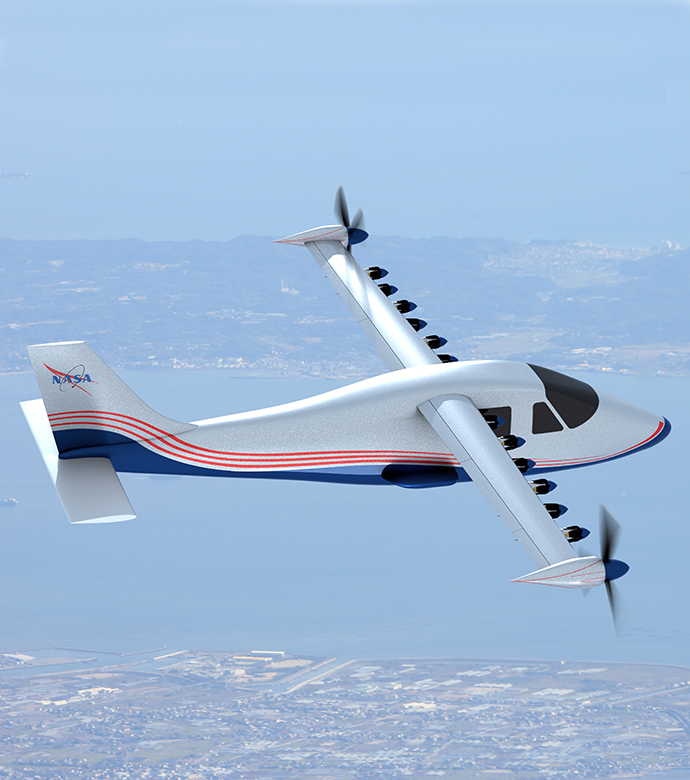High-Voltage Power System for Hybrid Electric Aircraft Propulsion
power generation and storage
High-Voltage Power System for Hybrid Electric Aircraft Propulsion (LEW-TOPS-104)
Variable-frequency, doubly-fed electric machines improve efficiency and reduce weight
Overview
Innovators at NASA's Glenn Research Center have developed a variable-frequency, alternating current (AC) power system to enable turbo-electric and hybrid electric propulsion. Glenn's technology uses double-fed electric machines and a high-voltage, variable-frequency power system to significantly decrease (by 85%) the weight of an aircraft's power electronics for turbo-electric propulsion, while still providing high specific power and variable thrust. To provide a safe system, the lightweight electric machines operate at high frequency, allowing fast detection and clearance of faults without requiring switchgear that interrupts the current. This design also reduces the protection system's weight, while improving reliability by minimizing fault energy and collateral damage potential. In addition, the system permits either sub-synchronous or super-synchronous operation relative to throttle position, without having to adjust turbine settings. Glenn's innovative system raises the ceiling for hybrid electric aircraft.
The Technology
Glenn's novel system supports the NASA Aeronautics Research Mission Directorate (ARMD) strategic plan to leverage advancements in technologies over the next 25 years and beyond, leading to new aircraft configurations with enhanced performance, improved energy efficiency, and reduced CO2 emissions. The electric system is a multi-megawatt micro-grid that converts mechanical energy to electric via generators, and electric energy to mechanical via motor-driven fans. This innovation would use the variation in aircraft throttle settings to produce a high-voltage (20 kilovolts), variable-frequency 9-phase AC distribution system. Using doubly fed electric machines (generator, propulsor, and flywheel) allows for field excitation that can cause variable-frequency or variable speed operation around the commanded throttle setting. The flywheel enables an energy storage system that recovers and reuses energy, while the flywheel slews with the throttle control using the electromagnetic torque produced by the doubly fed electric machine. This design permits both sub-synchronous and super-synchronous operation using limited field excitation power provided through power converters. Finally, the reduced switchgear mass facilitated through the use of a high-frequency AC system, setting-less protection zones, and simplified switches for fault clearance provides enhanced operational capability. This system can be controlled so that fault energy is minimized, preventing collateral damage to aircraft structures even with high voltage distribution. Glenn's innovative system adds performance, efficiency, reliability, and cost savings to cutting-edge hybrid electric technology.
This is an early-stage technology requiring additional development, and Glenn welcomes co-development opportunities.


Benefits
- Cost-effective: Reduces weight significantly in both the power system and the protection system, yielding greater fuel efficiency and very low carbon emissions
- Efficient: Provides 30% variation around engine throttle settings and a maximum of 60% differential variation for twin engine aircraft, so fewer turbine adjustments for variable thrust are needed
- Reliable: Provides increased redundancy due to the multi-mode operation for the doubly fed electric machines and reduction in power electronics and thermal subsystems
- Safer: Uses high-frequency AC and differential protection zones that minimize collateral damage through fast detection and isolation of faults
- High-performance: Offers enhanced turn and bank control through distributed propulsion and use of sub and super-synchronous operation of the doubly fed electric machines
Applications
- Aerospace
- Unmanned vehicles
- Power (e.g., microgrids)
- Marine
Technology Details
power generation and storage
LEW-TOPS-104
LEW-19294-1
LEW-19294-2
Similar Results

Power Processing Unit (PPU) for Small Spacecraft Electric Propulsion
Key subsystems of a scalable PPU for low-power Hall effect electric propulsion have been developed and demonstrated at NASA GRC. The PPU conditions and supplies power to the thruster and propellant flow control (PFC) components. It operates from an input voltage of 24 to 34 VDC to be compatible with typical small spacecraft with 28 V unregulated power systems. The PPU provides fault protection to protect the PPU, thruster, PFC components, and spacecraft. It is scalable to accommodate various power and operational requirements of low-power Hall effect thrusters. An important subsystem of a PPU is the discharge supply, which processes up to 95% of the power in the PPU and must process high voltage to accelerate thrust generating plasma. Each discharge power module in this PPU design is capable of processing up to 500 W of power and output up to 400 VDC. A full-bridge topology operating at switching frequency 50 kHz is used with a lightweight foil transformer. Two or more modules can operate in parallel to scale up the discharge power as required. Output voltage and current regulation controls allow for any of the common thruster start-up modes (hard, soft or glow).

Thermal Management for Aircraft Propulsion Systems
Aircraft thermal management systems typically comprise over half the mass associated with full electric power propulsion systems, with significant negative impact on fuel efficiency. In addition, the traditional method of using jet fuel to cool aircraft generators does not provide enough cooling for use in flight-weight cryogenic systems. Lastly, the much higher bus voltages required for flight-weight systems (4.5 kV vs. 270 V) introduce additional spark-ignition hazards associated with alternative cryogenic cooling fuels, including liquid methane or liquid hydrogen. The Glenn flight-weight thermal management system addresses all of these problems by using the considerable waste heat energy from turbogenerators to create a pressure wave thermoacoustically. This wave can then be delivered quietly and efficiently via routed ductwork to hollow pulse-tube coolers located near any component in the aircraft that requires cooling. The tubes can be fabricated in any length and can be curved to fit any space. This technology also allows waste heat energy to be used in at least four ways: 1) the waste heat energy can drive a thermoacoustics-based ambient or cryogenic heat pump; 2) it can be channeled directly into a thermoacoustic engine that generates power; 3) it can convectively preheat the fuel/ or air supplied to the aircraft engine; 4) it can drive a pulse-tube generator providing power. The delivered thermoacoustic power can provide cabin cooling as well as ambient/cryogenic cooling of converter, cables, and motors. In addition, this power can be converted to local electric power through the use of a transducer (such as a linear alternator) or piezoelectrics. Further, the efficient thermal management system enables the size, mass, and resultant cost of the radiating fins to be reduced. Glenn's system offers an efficient method of cooling next-generation flight-weight electric aircraft with significant benefits for fuel efficiency and safety.

High Efficiency Megawatt Motor
The HEMM is a is a wound-field partially superconducting machine that implements a combination of rotor superconducting and stator normal conductor elements, along with an integrated acoustic cryocooler, to achieve some of the benefits of a superconducting motor without the need for an external cryogenic system. The combination of the described elements allows a motor to be built which essentially operates like any other motor when viewed as a black box, but substantially enhanced performance can be achieved. The incorporation of superconductors on the rotor to create a high-level magnetic field results in a specific power and efficiency that could not be achieved any other way. The HEMM can achieve over 98% efficiency in a lightweight electric machine with an operating power greater than 1.4 MW, a specific power greater than 16 kW/kg (ratio to electromagnetic mass), and a rated operating speed of 6800 RPM. The HEMM can be used as both a motor or a generator, offering a wide range of applications including propulsion systems for hybrid aircraft, electric trains, hybrid cars, and turboelectric ships, as well as generator systems for wind turbines, power plants, or motors for other industrial machinery.

Small Spacecraft Electric Propulsion (SSEP) Technology Suite
Innovators at GRC have developed a suite of SSEP technologies for small, low-power spacecraft using Hall effect thrusters including a high propellant throughput small spacecraft electric propulsion thruster (LEW-TOPS-158), a power processing unit for SSEP (LEW-TOPS-157), an anode manifold plug for Hall effect thrusters (LEW-TOPS-159), and additional Hall effect technologies (LEW-TOPS-34). See the Additional Information section at the bottom of the page for more information on each technology suite component.
GRC is making these technologies available to U.S. companies through a no-cost*, non-exclusive license agreement and companion Space Act Agreement. Licensees may receive a comprehensive package of design and process documents including issued and pending patents, design drawings, materials specifications, and test data. Licensees will assist in defining system requirements and creating new platforms to use the SSEP technologies. This streamlined, collaborative commercialization strategy helps satisfy NASA exploration and science mission requirements while improving U.S. competitiveness in the global electric propulsion market and improving the success of new electric propulsion developments. Working alongside our licensees, GRC hopes to generate a compendium of SSEP knowledge as a living document, maintained by all users in a consortia-like environment.
*Although the license and Space Act Agreement are no cost to the licensees, licensees would be responsible for setting up and maintaining an EAR restricted file sharing space.

Efficient Megawatt-Scale Cable for Electric Aircraft Propulsion
Distilled to its core components, the cable is composed of either a flexible or rigid transmission line with integrated oil-based cooling. Instead of solid wire, current flows through small conductive tubes made of aluminum or copper, which are actively cooled by pump-driven oil flowing through them. Although these smaller conductors have higher resistance and generate more heat, the active cooling offsets this heat generation. This integrated design results in a cable with up to a tenfold improvement in weight per megawatt of power delivered compared to existing solutions.
The use of smaller conductive cables with active cooling reduces the temperature requirements for insulation because more current can be run through the cable. As such, voltage can be reduced, mitigating partial discharge issues, and making insulation an easier engineering challenge. Due to significant weight reductions, specialized duct work is no longer needed. A collection of junction, splicing, and termination components allow the cable to be built into a power and thermal bus to service multiple electrical components.
Initial tests demonstrated the ability to conduct 1,000 amps through actively cooled cables at lower mass than state-of-the-art alternatives, confirming feasibility for next-generation aircraft electrification. However, the cable has broad applications across all vehicle electrification where weight and thermal management are high priorities and is now available for patent licensing.



